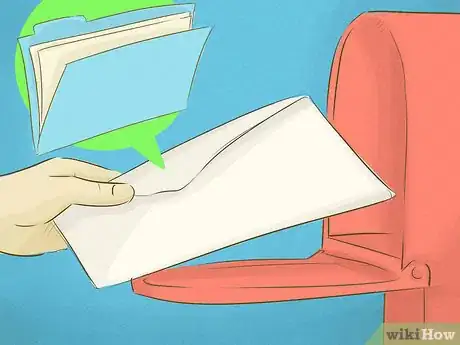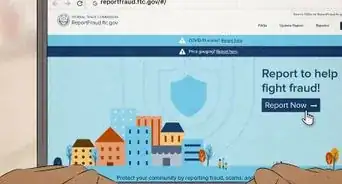This article was co-authored by Clinton M. Sandvick, JD, PhD. Clinton M. Sandvick worked as a civil litigator in California for over 7 years. He received his JD from the University of Wisconsin-Madison in 1998 and his PhD in American History from the University of Oregon in 2013.
This article has been viewed 88,806 times.
The right to petition the U.S. government is set forth in the First Amendment and this right allows Americans to formally stand together and demand change on a particular issue. While the petition may be a less used avenue to address political leaders, it provides and important way for everyday people to make their voices heard and to ask elected officials to take action. If you feel passionate about an issue, the petition is a low-cost way for you to take a stand for change in your community. Additionally, petitions can be used to allow voters to place proposed laws or constitutional amendments on a ballot during an election. These types of petitions may also be called "initiatives" or "referendums."
Steps
Creating a Petition
-
1Identify a problem that you want the government to address. Whether it’s national gun regulation or the placement of a stop sign at a busy intersection, you must identify an issue that you feel strongly about and on which you want the government to take action.
-
2Check governmental requirements for petitions. State or local governments may set forth specific requirements for a petition. You should contact your local governmental agency and inquire as to any requirements and request a sample petition. These requirements could include:
- The type of information that must be contained in the petition.
- The format of the petition.
- The number of signatures required.
- Whether you are required to get permission for your petition before you begin to circulate it and collect signatures.
- Names and addresses of designated representatives.[1]
- If you are petitioning a governmental entity, you should also check whether there was already a petition filed on the matter and ask the agency what the rules are regarding duplicate petitions. Governmental petitions have specific rules and you should be sure that your new petition isn’t declared invalid because it is duplicative.[2]
Advertisement -
3Create your own petition. Your petition should contain specific information detailing your cause and the steps that you want taken by the government. When drafting your petition, be sure that the petitions has a title that captures the essence of your campaign and includes your name and contact information.
-
4State your demands. Your petition should contain a section that specifically and concisely states the issue that you want addressed and the response that you are demanding from the governmental agency. If you are requesting that a new park be built in your area, do not simply say “we would like a new park.” Instead say, “we demand that the Council of Parks and Recreation allocate money to fund a new park in the Lincoln district of our town.”
- If your petition is related to a law or rule, specify the exact language that you want to change, add, or remove with your proposal.
-
5Make a well-supported argument. In order to have a successful petition, it must contain a strong argument supported by evidence. Your argument should show how your proposal would benefit the general public. For example, you could argue: “We require a new park for the Lincoln district because our district does not have any parks. We need an area where our children can play safely outdoors and learn about and enjoy nature. Studies have shown that children who spend at least 60 minutes a day playing outside are at a decreased risk for childhood obesity and other health concerns. By providing a safe and educational space for children to play outdoors, the Council of Parks and Recreation will be contributing to the health and well-being of the community’s children.”
- Include documents and data that support your argument. Create a petition that includes facts, charts, graphs, scientific evidence, or photos that demonstrate why your proposal is sound, necessary, and a benefit to the community.
- List laws or rules that support your proposal.
-
6Create a signature form. This is the page (or pages) on which people add their signatures. Put the petition title on the top of the page (for example, Petition for New Park in Lincoln District). While each state or local government may have specific rules about what information to contain on the signature page and how the page should be formatted, generally some or all of the following information is required:
- Signer’s printed name.
- Signer’s signature.
- Signer’s residence address.
- Signer’s county.
- Signer’s voter registration number.
- Date the petition was signed.
Gathering Support for Your Petition
-
1Speak to people in person. For an issue of importance to a local community, you may generate the most support by speaking to community members in person. When gathering signatures for your petition, consider the following:
- Go to public places where you will be able to speak to the most people who you think will be impacted by this petition. If your petition is for a public park, attend local youth sporting events and speak to parents.
- Attend town hall meetings, public forums, or other public gatherings where people are discussing community issues. This group of concerned citizens may be most sympathetic to your petition and support your cause.
- When approaching community members with your petition, always be polite and considerate. No one wants to be bombarded by an angry petitioner when they are simply trying to get to work.
- Be mindful that even if someone supports your cause, he or she might be unable to do so at that exact moment either because of time or economic constraints. Simply thank them for their time. These same people may remember your polite demeanor and contact you when they have the resources or time to do so.
-
2Spread the world through email. Email your petition to all of your friends, family, and acquaintances. After emailing your original petition, send two or three follow up emails requesting new support and updating your supporters on your progress.
-
3Create an online presence for your petition. Whether you use an online forum, social media, or a blog, creating an online presence can dramatically increase the number of people you can educate and inform about your petition. Consider the following when creating an online presence for your petition:
- Create an area for discussion so that people can ask questions and you can respond.
- If you are required to submit hardcopy signatures, choose a few convenient times and locations (such as a local grocery store) where people can stop by and sign the petition.
- Use a variety of social media platforms to spread your message.
- It is particularly important to create an online presence for your petition if your petition concerns a national issue. Consider using online petition organizations such as change.org that pass your petition to its registered users. The White House also has a petition website, where you can both create and sign petitions located at https://petitions.whitehouse.gov.
-
4Use the media to bring attention to your issue. Contact local newspapers and television news media and educate them about your issue and its importance to the community. Local news media often highlights stories of local interest and importance. This type of coverage can help you reach a broader audience.
Filing Your Petition
-
1Send your petition to the appropriate local, state, or federal agency. All levels of government have different rules governing how you can file a petition. To identify the requirements for filing a petition in your community, consider the following:
- Visit your state’s website. Conduct an internet search with your state’s name followed by “petition requirements.” The search usually directs you to the appropriate links.
- For a government agency, check the agency's website for instructions on where to send or file a petition. Typically, there will be a search window on the website where you can search for “petition.”
- Locate the proper place to submit a petition. Some agencies have a central office that receives all petitions, while other agencies ask that you send petitions to specific officers. For instance, if you were filing a petition to have an Act placed on the ballot in the state of Maryland, you would need to send your petition to the Secretary of State in Maryland.[3] You can usually locate this information on the agency’s website or by calling the agency directly.
- Call your local or state government’s office, and ask to speak with a clerk about the steps that you can take to file your petition.
-
2Look for agency acknowledgment and receipt of your petition. Each state and federal agency handles petitions differently. The agency you filed your petition with may post notices to the public on their websites, publish a receipt of notice on the Federal Register or contact you personally. You may be able to locate this information within the petition requirements or by asking the agency directly.
-
3Wait while your petition is processed. There is no general rule that specifies when different levels of government must respond to a petition. You should ask the agency you are petitioning when you should expect to hear a decision.
- Some agencies set forth a specific timeline, such a 30 days.
- Some agencies may open the petition up to public input, which extends the decision-making timeline.
- Some agencies may consider your petition privately and internally.
- Decisions on federal rulemaking petitions are published in the Federal Register.
Writing Proposed Initiative Measures
-
1
-
2Seek the assistance of a lawyer. The first step in the initiative process is writing the proposed law. Before you sit down and write the law yourself, you may want to consider hiring a professional. Lawyers have an understanding of how laws are often formatted and worded, and they are great resources at the beginning of the initiative writing process.
- If you are seeking the assistance of a lawyer, see if your state has any lawyers that specialize in drafting initiatives.
- If you cannot find a lawyer that specializes in this matter, try finding an attorney who specializes in the subject matter the initiative is about. For example, if you are going to draft an initiative about the criminal justice system and sentencing laws, you should obtain the help of a criminal lawyer.
-
3Obtain assistance from the government. In some states, for example California, you can ask the Office of Legislative Counsel for help. In order to do so, you must get the signature of 25 or more electors and make a presentation to the Legislative Counsel. The Legislative Counsel will determine if they should assist, and if they decide to, they will draft the proposed law.
-
4Write the proposed law yourself. If you wish, you can always draft the proposal yourself. To do so successfully, you will need to draft a persuasive and actionable proposal. For example, you should create an engaging and truthful title. It should be something that explains what the initiative is about but it should not mislead readers. Additionally, the initiative language should be grammatically correct, actionable, and decisive.
- A poorly worded ballot measure can lead to minimal support and ultimately failure on election day. If you have the resources, you should consider using an attorney or the Legislative Counsel.
-
5Ask for a review. After you have prepared the initiative's language, you can often ask to have it reviewed by someone in the government. In California, you can ask the Secretary of State to review the proposal with respect to form and language clarity. The Secretary of State will also obtain a statement of fiscal impact, which will detail the budgetary impact of any proposed law.
Requesting Government Action
-
1Submit the proposed initiative to the attorney general. Once the proposed law has been written, you will need to submit it to your state government. When you submit the initiative, you will also request that the government create a working title and summary of the initiative.
- In California, you will submit your request to the Attorney General. The Attorney General will be responsible for creating a title for the initiative and for providing an official summary.
-
2Pay the required fee. At the same time you submit your proposal, you will be required to pay a certain fee. In California, the fee is $200 and it is placed in a trust fund. If the proposal makes it on the ballot within two years of submission, the fee will be refunded. If your proposal fails to make the ballot, the fee will be kept.
-
3Sign the required certification. When you submit the proposed initiative, you will have to sign a certification stating that you are a citizen of the state where you are submitting the initiative. In addition, you will usually have to submit your contact information so people can get ahold of you.
-
4Execute a prepared statement. In most states, you will also have to sign a statement promising to not use any signatures you receive for improper purposes.
-
5Allow for public review. After you have signed and submitted everything, the government will distribute the initiative for public review. In California, public comment needs to last at least 30 days. During the public comment period, any member of the public can submit written comments about the proposed initiative.
Gathering Support
-
1Circulate your petition. The last step in the initiative process is the signature process. All states will provide you with a maximum amount of time your proposal can circulate. In California, you are allowed a maximum of 180 days to circulate your petition and get signatures.
-
2Obtain the required number of signatures. Each state will have laws on how many signatures are necessary to get an initiative on the ballot. Be sure you know these requirements and set goals that exceed the minimum signature requirements. In California, if you are proposing a statute, you will need a minimum of 365,880 signatures. If you are proposing a constitutional amendment, you will need 585,407 signatures.
- Be aware that only signatures of citizens who are registered to vote will count. Therefore, some signatures you receive will most likely not count. this is why it is important to get more signatures than just the minimum.
-
3Turn in your signatures. Once you have collected the required number of signatures, you will submit the petition to the required government entity. At this point, the petition process is complete.
References
- ↑ http://www.sos.state.tx.us/elections/laws/petitions.shtml
- ↑ http://ctb.ku.edu/en/table-of-contents/advocacy/direct-action/petition-drive/main
- ↑ http://www.elections.state.md.us/pdf/6-201-3a.pdf
- ↑ http://www.ncsl.org/research/elections-and-campaigns/chart-of-the-initiative-states.aspx
- ↑ https://oag.ca.gov/initiatives/faqs
About This Article
To file a petition, start by contacting the state or federal government to learn about any filing requirements, which may include the format of the petition and minimum number of signatures required. Then, create your petition with a concise description of the issue you're concerned about and demands you want the government to consider. Next, gather signatures for your petition by campaigning online and in your local area. When you're ready to file, locate the correct address to send your petition to on the local, state, or federal government agency's website. For tips on how to make a strong argument in favor of your cause and how to write a ballot initiative, read on!

















































































